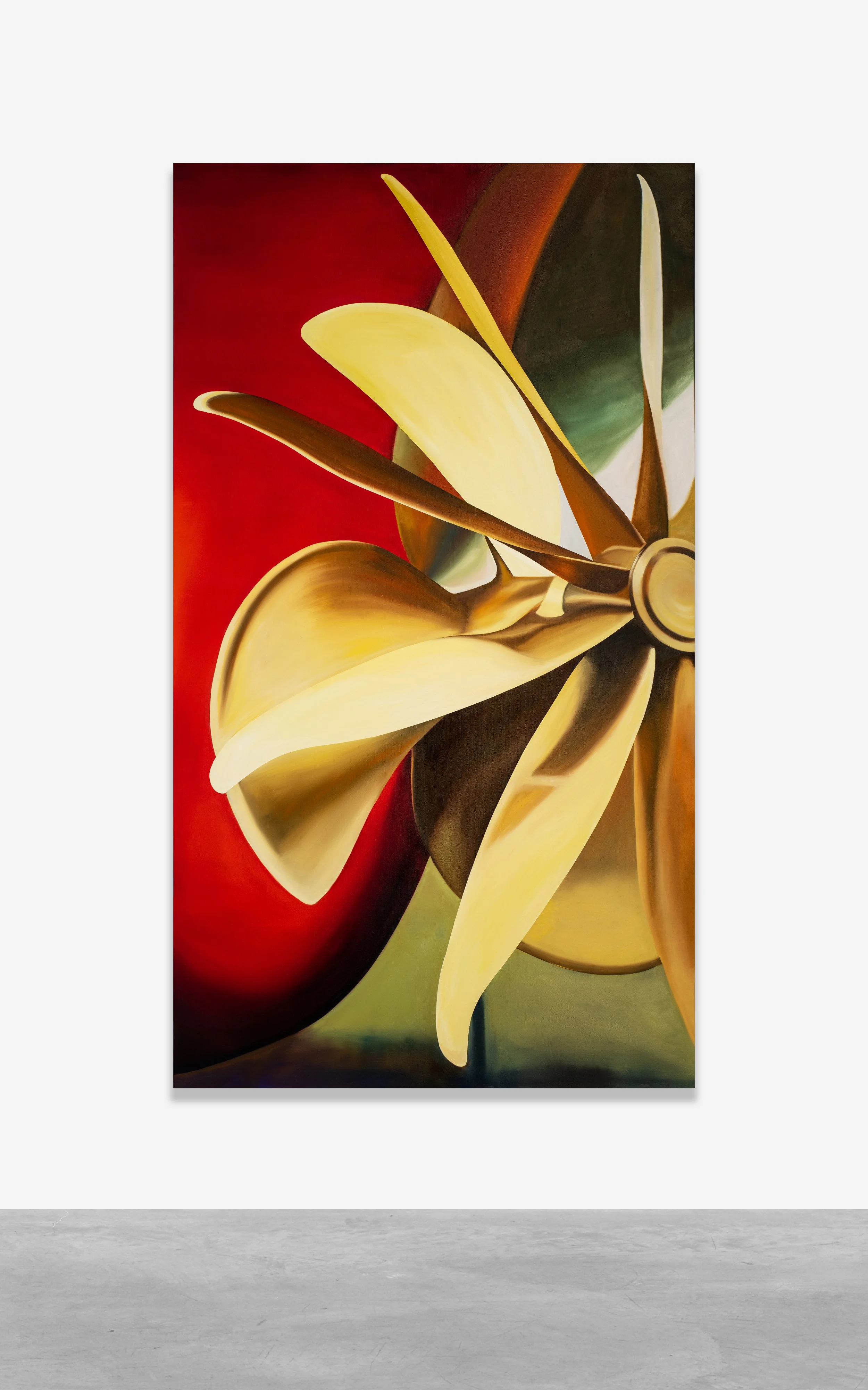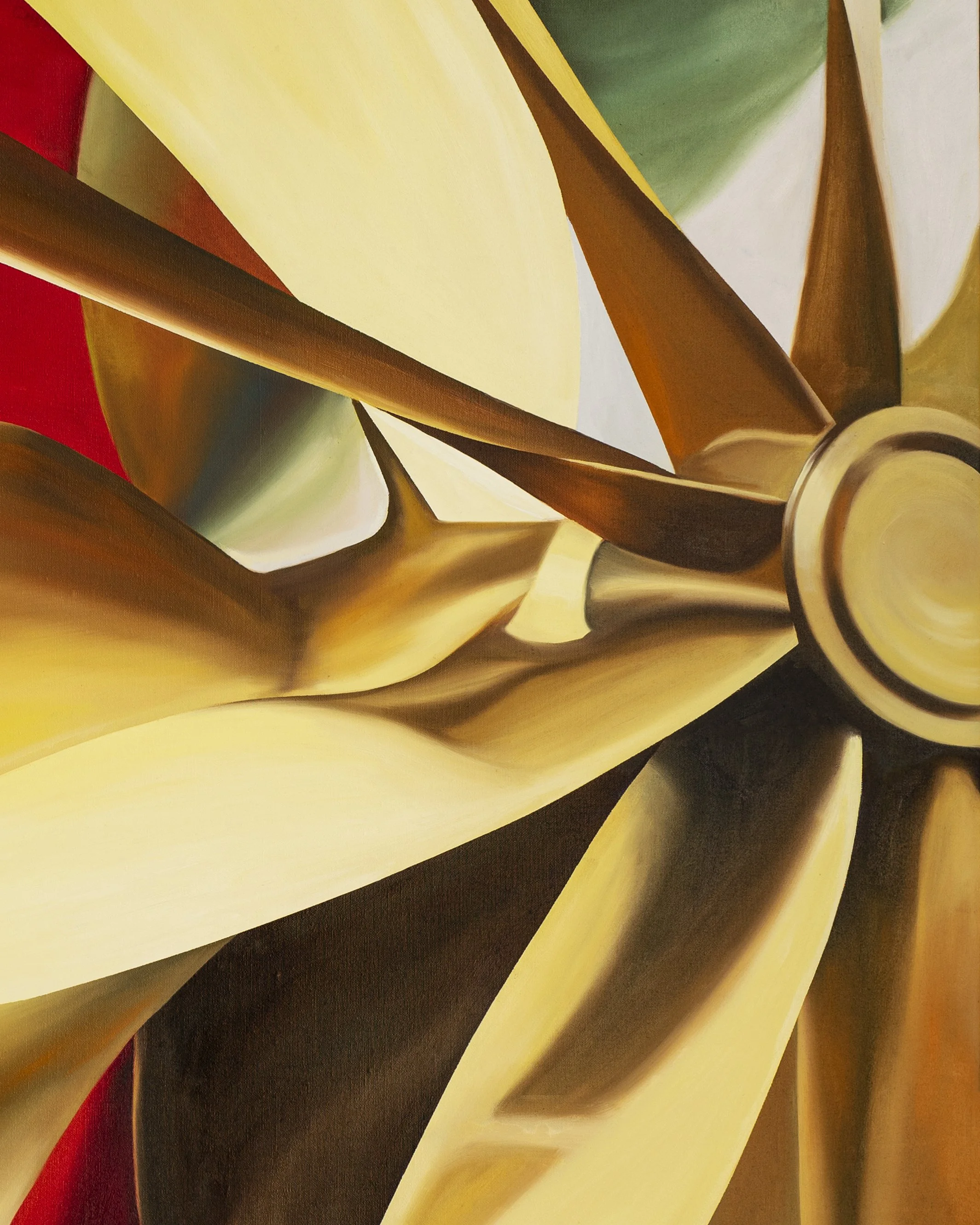The Wave 02, 2024
The Wave 02, 2024
Oil on linen
165 x 92 cm ( 65 x 36 in)
The Wave series, inspired by propellers and mechanical technology, delves into the intricate and often unseen forces that propel modern machinery forward. Through these works, Tan Mu examines the mechanics and profound influence of propulsion technology, inviting viewers to contemplate the delicate interplay between human ingenuity and the natural world. In her meticulously crafted oil paintings, Mu captures the essence of the propeller, highlighting its significance as a technological marvel central to maritime transportation and global trade. Beyond their functional importance, the Wave series encourages a deeper reflection on the broader implications of such advancements. It challenges us to reconsider our relationship with nature, recognizing how technological progress shapes and transforms our interactions with marine environments and ecosystems. A visual meditation on innovation and its consequences, the Wave series urges us to appreciate both the beauty and the far-reaching impact of technological evolution in our interconnected world.
Q: Your The Wave series is inspired by propellers and machinery. Could you discuss the background and core concept behind this series?
Tan Mu: Container (2021) was my first work depicting maritime logistics, and The Wave series continues my exploration of this theme. My interest in maritime transport is deeply tied to my family history—my great-grandfather was a sea merchant during the Nationalist era. He spent much of his life navigating the international waters between China and Korea, engaged in trade and cultural exchanges. His stories inspired me to explore the journey of goods and ideas across the seas, reflecting on how containers carry not only physical commodities but also cultural, emotional, and informational layers. In The Wave, the depiction of propellers is my exploration of the maritime power that combines the flow of nature with mechanical force, delving into the relationship between technology and nature. Although a mechanical device, the propeller’s operation mimics the flow of natural elements like ocean waves, air currents, and even the spiral structure of DNA. The beauty found in this paradox, the unity of opposites, fascinates me.
Q: You mentioned the dynamic energy and spiral structure of the propellers as key themes in this series. Could you elaborate further?
Tan Mu: The propeller generates fluctuations and vortices as it spins, and this dynamic energy greatly interests me. In my work, I express this rotating energy through lines and the golden hues that evoke a sense of motion. The toroidal shape of the propeller is consistent with structures in my other works, such as Torus (2020, 2021), the Gaze series, and works depicting cells, black holes, atoms, and more. These pieces reflect my focus on the interconnectedness of kinetic energy and the natural energy cycles in the universe. The spiral structure of the propeller is not just a mechanical design—it symbolizes natural energy cycles, such as water vortices, atomic rotations, and even cosmic energy flows. My work celebrates the beauty of nature and energy. The spiral kinetic energy, from micro to macro scales, is a central theme I seek to capture in this series. Through painting, I hope the viewer can sense the life force and dynamic quality behind the mechanical function.
Q: In the first piece of The Wave series, you depict a massive propeller along with surrounding figures. Could you describe the creative process for this work?
Tan Mu: This work is inspired by my interest in globalization and maritime transport. As cargo ships have grown larger, propellers, as the core components of propulsion, have also expanded in size. In 1934, the Museum of Modern Art (MoMA) held an exhibition called Machine Art, showcasing the industrial technology of the time, where the propellers on display were less than one meter. Today, the largest propellers can have diameters of up to 8 meters. To reflect this technological progress, I included a small figure in the painting for scale comparison, highlighting the immense size of the propeller and the labor required to construct such a massive component. Through this, I aim to document this technological marvel and encourage viewers to reflect on the impacts of technological advancement and globalization.
Machine Art, 5 March to 29 April 1934
Q: You mentioned that gold plays a symbolic role in your work. Could you explain this further?
Tan Mu: Gold in this piece is more than just a color; it’s a symbol. Historically, gold has been viewed as rare and precious, representing reverence and power. In this work, the polished metal of the propeller is rendered in gold, symbolizing the worship of technology. It seems that modern society has entered an era of technological reverence, where breakthroughs such as quantum computers, large turbines, particle colliders, and microchips have become objects of our admiration. Through the use of gold, I wish to express this feeling of technological adoration and draw a parallel to the totemic reverence in primitive tribes.
Q: Aside from The Wave series, do your works explore other ocean-related facilities and technologies?
Tan Mu: From my earlier work, Container (2021), to the ongoing Signal series, many of my pieces focus on ocean-related facilities and technologies. The Signal series, in particular, is a continuous exploration of the hidden underwater infrastructure of global submarine cables. In The Wave, the operation of the propeller symbolizes not only power on the water’s surface but also resonates with the underwater cables. These cables are crucial to global information transmission, just as the propeller is essential to global freight transport. Together, they form the backbone of globalization. This connection reminds me of the exploration of information networks in the Signal series. Whether through the transmission of information or the movement of goods, both carry emotional and memory connections, illustrating how technology expands boundaries and links the world.





